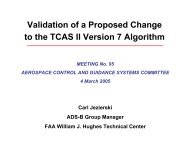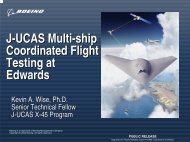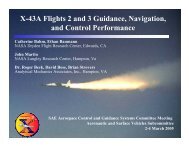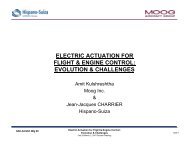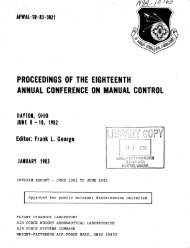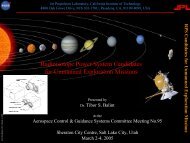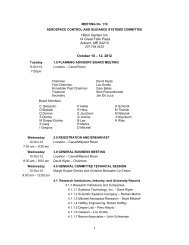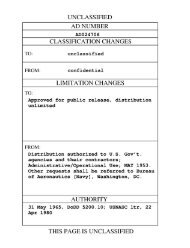Report of the Second Piloted Aircraft Flight Control System - Acgsc.org
Report of the Second Piloted Aircraft Flight Control System - Acgsc.org
Report of the Second Piloted Aircraft Flight Control System - Acgsc.org
You also want an ePaper? Increase the reach of your titles
YUMPU automatically turns print PDFs into web optimized ePapers that Google loves.
CENTERING CHARACTERISTICS OF POWER BOOSTED<br />
AIRCRAFT CONTROL SYSTEMS<br />
Within fi basically different aircraft, <strong>the</strong> Glenn L. Hartin Cagp~y h e<br />
designed and put into service 30 different pouered surface control system <strong>of</strong><br />
Mch 1S wore power operated. The remnining fi power boosted surface control<br />
eystsaPs have presented an umwual combination <strong>of</strong> requiremanta for sensitivity,<br />
stability, and oenterlng, To meet such requiranants while m&Lntabing a<br />
simple, reliable mchanlsm, devoid <strong>of</strong> functionally oanplicated acoeesaries,<br />
<strong>the</strong> designer muat provide <strong>the</strong> optimtun system arrangement Md go to a high<br />
degree <strong>of</strong> reiinemant in designing <strong>the</strong> elements.<br />
i<br />
The design considerations in a powa: boost& Waft controls ayutcrn<br />
are as follows:<br />
1. To provide optimum sensitivity and tbe correct amount <strong>of</strong> ponm at<br />
all coaPbinatlo~ <strong>of</strong> speed and load.<br />
2. To prevent any fom <strong>of</strong> imtability such aa ohattor or hunt Yithkl<br />
. <strong>the</strong> meohanism in spite <strong>of</strong> <strong>the</strong> rensitivity and 1w break-atmy<br />
iriotion.<br />
3. To obkin a high degme <strong>of</strong> system raversibility ro that th.<br />
mechanism will accurately centor or return fo <strong>the</strong> t M podtion,<br />
ud so that a good forcre gradlent will k felt by <strong>the</strong> pilot at vexy<br />
low aerodynsrPic moments.<br />
Theee considerations are close2 y interrelated by m~ll~r 6y8tem perpplbtms<br />
which generally am determined by one consideration and haw a direct effeot<br />
on <strong>the</strong> o<strong>the</strong>r tuo. Consideration #1 determines eyetan rate gain, drcuit<br />
powor, and valve chprrcteriaticr, each <strong>of</strong> which has a dinat effmt upon<br />
rtability (consideration #2). Stability ale0 concams <strong>the</strong> irlction or damp-<br />
In# throughout <strong>the</strong> system, <strong>the</strong> point <strong>of</strong> application <strong>of</strong> <strong>the</strong> actuator, md <strong>the</strong><br />
method <strong>of</strong> obtaining proportional feel, each <strong>of</strong> which vitally affwte tho<br />
csntsrlng charactaristics (considaration #3).<br />
There an definite perfonaance requirement6 hlch rmst be mat for<br />
sensitivity, stability, and cgltering to make any system ratirfmtary in<br />
r&oe. The ability <strong>of</strong> <strong>the</strong> designer to maat .those roquiruaatr depend.<br />
upon hlr undarrknding <strong>the</strong> effect <strong>of</strong> woh rymtsrp p.ramstw upon tb, roquirm<br />
ds. For amupla, to nuke a Judioious deoidon mgardlnq <strong>the</strong> magnituda<br />
md dlrtribution <strong>of</strong> fiiotion, <strong>the</strong> designer must &tormine <strong>the</strong> mulmum<br />
pumisrible frlctlon pattorn from his ertabllahod oentoring roq-mmnb, -<br />
nut det8rmlne by rnolysis or tat <strong>the</strong> mlnbmm Mction pattarn ro@s~d to<br />
arintaln stabill*, and <strong>the</strong>n he our establirh <strong>the</strong> quality aontrol llritr <strong>of</strong><br />
mation dtbin eaah el-t <strong>of</strong> <strong>the</strong> qmtau.<br />
*<br />
Centering charrctsrlrtlor M reford to harein ary be d<strong>of</strong>Y.nod u <strong>the</strong>'<br />
rolaWonahip be- force, podtion, and rate <strong>of</strong> motion <strong>of</strong> a oontrol ~ Ifrr<br />
in <strong>the</strong> rlcinity <strong>of</strong> <strong>the</strong> tadmned neutral position, Tho oritioal paiotr<br />
ordinarily oonai&nd rre u followst



